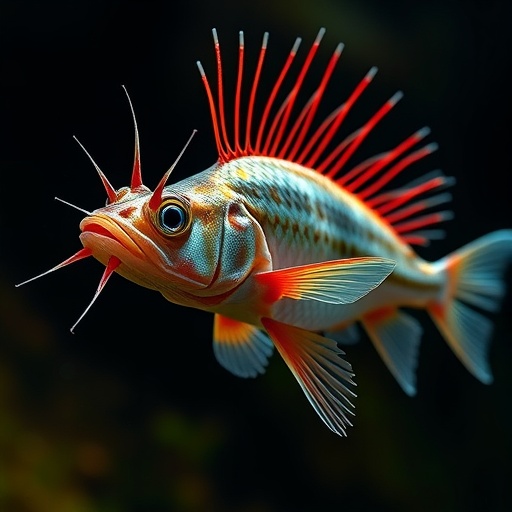Venomous fishes have long captivated the imagination of scientists and enthusiasts alike, not merely due to their often vibrant colors but also because of their fascinating adaptations, particularly their spines and venom delivery mechanisms. Recently, a groundbreaking study published in Discover Animals details the intricate morphology of these spines and the associated milking practices for venom extraction. This research, carried out by a team of experts, seeks to unravel not only the physical characteristics of these fishes but also the methodologies that could potentially enhance the understanding of their venom systems.
The adaptive evolution of spines in venomous fishes is a remarkable example of nature’s ingenuity. These structures play a crucial role in defense and predation, deterring would-be predators while aiding in the capture of prey. The studied species exhibit a variety of spine forms, each tailored to their unique environments and ecological niches. The examination of these morphological traits provides invaluable insights into the evolutionary pressures that have shaped their development over millennia.
Among the multitude of species analyzed, researchers have identified distinct patterns in spine morphology that correlate with ecological factors such as habitat type and diet. For instance, species that inhabit coral reefs often possess longer and more aggressive spine structures, which not only protect them from larger predators but also assist in navigating the complex underwater landscape of their environment. This specialization indicates an evolutionary trajectory influenced heavily by both predation and competition for resources.
In their study, the team delves into the mechanics of venom delivery. The spines of these fishes are not just passive weapons; they are intricately linked to a sophisticated venom apparatus. The research highlights how spines can function as conduits for venom introduction into a target, effectively combining physical defense with biochemical warfare. The interplay between morphology and function illustrates a high level of evolutionary engineering, suggesting that these adaptations have been refined through countless generations of natural selection.
The extraction of venom—referred to as “milking”—is another significant focus of the study. Researchers demonstrated various practical techniques for safely obtaining venom samples from specific venomous species. These methods are essential not only for scientific research but also for the development of antivenoms and other medical applications. The advent of milking practices represents a convergence of ecology and pharmacology, merging knowledge of animal behavior with the budding field of biomedicine.
Indeed, the implications for medical science are vast. Understanding the composition and function of venoms can lead to the discovery of novel compounds that may serve therapeutic purposes. For example, certain peptides found within the venoms of these fishes exhibit properties that could be harnessed for pain management or other medicinal functions. This crossing of disciplines underscores a new frontier in scientific research, where traditional biological studies pave the way for innovative healthcare solutions.
As researchers document the various milking techniques and their effectiveness, the study emphasizes safety protocols to minimize harm to both the fishes and the handlers. The intricate nature of venomous fishes requires trained professionals to engage in safe practices that protect the integrity of these delicate ecosystems while allowing for scientific progress. This ethical approach to research is essential in navigating the complexities of wildlife conservation alongside scientific discovery.
The study also raises pertinent questions regarding the conservation of venomous fishes. As habitats face increased pressure from human activity, including overfishing and environmental degradation, the need for sustainable practices becomes imperative. Researchers advocate for the conservation of these species by highlighting their ecological importance and the potential benefits they can offer through bioprospecting. Ecosystem health is intrinsically linked to the survival of venomous fishes, and protecting these creatures is vital for maintaining biodiversity.
Moreover, the authors note the importance of public engagement and education in fostering a greater understanding of venomous fishes. By enabling communities to appreciate the role these animals play in their ecosystems, there lies an opportunity to encourage conservation efforts. Initiatives aimed at knowledge dissemination, such as workshops and educational programs, could play a pivotal role in dispelling myths surrounding these often-misunderstood creatures.
In dissecting the relationship between morphology and behavior in venomous fishes, the study’s findings may empower future research efforts aimed at uncovering the roles these animals play within marine ecosystems. The intricate balance between predator and prey creates a dynamic that is essential to the ecosystem’s overall well-being. Researchers now stand at the brink of unlocking further secrets held by these enigmatic species, providing a clearer picture of life underwater.
In conclusion, the study of venomous fishes encompasses an array of disciplines, from evolutionary biology to medicine and conservation. The insights garnered from their spine morphology and venom milking practices offer a glimpse into a complex world that warrants further exploration. As more researchers delve into these topics, the potential for groundbreaking discoveries grows exponentially, promising advancements in both science and conservation efforts.
This fascinating exploration into the lives of venomous fishes highlights the interconnectedness of marine ecosystems and the critical importance of preserving these incredible organisms. With continued research and dedication, we may pave the way for a brighter future where humans and nature coexist harmoniously, benefiting from the myriad wonders the ocean has to offer.
Subject of Research: Morphology of spines and milking practices in venomous fishes
Article Title: Morphology of spines and milking practices in venomous fishes.
Article References: Annona, G., Tarallo, A., Locatello, L. et al. Morphology of spines and milking practices in venomous fishes. Discov Anim 2, 53 (2025). https://doi.org/10.1007/s44338-025-00110-w
Image Credits: AI Generated
DOI: 10.1007/s44338-025-00110-w
Keywords: Venomous fishes, morphology, spines, milking practices, venom delivery, conservation, biomedicine, ecology.




